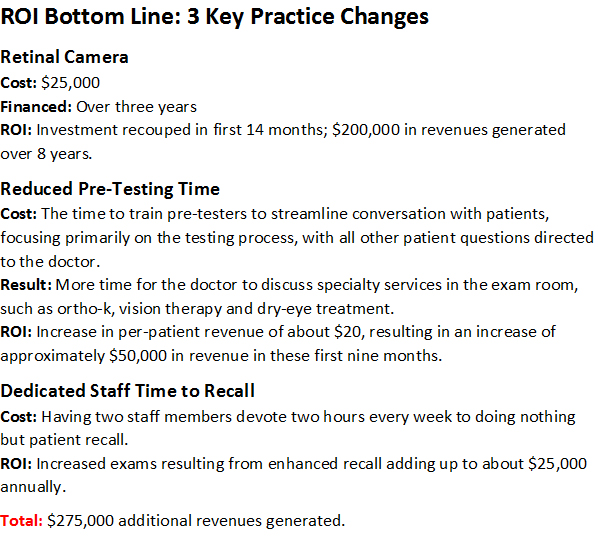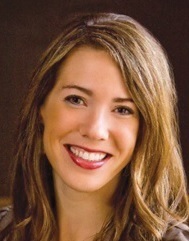By Gina M. Wesley, OD, MS, FAAO

June 13, 2018
Changes can bring about big shifts in patient care and profitability. Here are a few improvements my practice made that resulted in the ability to better serve patients, and to grow financially.
Retinal Camera
What was improved?
We gained the ability for retinal imaging for documentation, billing medical fundus pictures when indicated, as well as screening photos that patients could opt for as a private-pay revenue stream. A retinal camera is a fantastic way to document retinal health, and you can use it as an educational tool for your patients, so they better understand your diagnoses and treatment plan.
 Impact to profitability?
Impact to profitability?
I implemented the retinal camera in my second year of practice, and although many would now consider this to be a core piece of technology they have in their practices, 10 years ago it was still a luxury, optional item. By incorporating this testing, my revenues went up $20,000 in just the first year of having it in my fledgling practice. At the time, I was only seeing about 100 patients per month.
Cost?
The camera cost me approximately $25,000. The amount of time to implement was only the few hours of training we needed to take the pictures. I financed this instrument over three years time since I was still a new practice. I do think this is a purchase, though, that many practices could make outright, and start profiting from right away.
ROI
I calculate that I was able to recoup the cost of equipment within the first 14 months. I calculate I’ve generated approximately $200,000 in revenues from the camera over eight years.
Shortening Pre-Testing Time
What was improved?
My practice has morphed from being exam- and glasses-focused to also including specialty services such as ortho-k, dry-eye treatment and vision therapy. I had trained my technicians to ask specific questions during pre-testing, and be very engaging with the patients, however, I began finding that this lengthy exchange with patients took away from the time I had to discuss and communicate specialty services with patients.
So, I then streamlined the pre-testing process to include just polite dialogue specifically about the testing the patient was going through, and to direct specific questions to me, the doctor, when the patient asked. This has resulted in more time on my end to consult with the patient during each exam.
I was getting frustrated that it was taking 20-25 minutes after a patient had been checked in before I was with them. I knew that time was not being used wisely, so after observing for a few weeks, I decided to implement this improved patient flow.
Profitability?
I implemented this about nine months ago, and have seen an average increase in per-patient revenue of about $20.
Cost?
Zero costs other than coaching my techs on how to move through the pre-testing process.
ROI?
With the per-patient revenue increase, and the increase in the number of patients partaking in our specialty services, I calculate an increase of approximately $50,000 in revenue in these first nine months after making this change.
Creating a Dedicated Recall Center
What was improved?
I noticed that if our pre-appointed patients missed, or had to cancel, their exams, the lag time between when we would next get them in took several months. Additionally, not all our appointment slots were full, so although we concentrated on recall efforts, it wasn’t dedicated or specific. This was, in part, because we do an efficient job of pre-appointing and confirming those appointments. Or, we thought we were doing well, but a few patients every month started to add up.
I decided, after hiring another staff member, we had enough people to have a dedicated recall center to make sure specific hours were being used for recalling patients. I now have two staff members who work on recall two hours each, every week.
Profitability?
Since starting our recall center about three months ago, we’ve increased the number of exams by about 20 each month.
Attracting new patients is far more expensive than retaining established patients. Ensuring that the vast majority return every year for their exams is one of the most important tasks your staff can attend to. It needs constant attention and management, so make sure you have someone actively overseeing it.
Cost?
We had hired the new staff member for other reasons, so it was not a directly-related cost, but did give us the freedom to allow an established staff member to man the recall center (which was just a quiet work station we already had in place). It was just a matter of re-working the schedule to have the dedicated time for that staff member to do this recall work.
ROI?
I calculate these increased exams brought in approximately $25,000.
 Gina Wesley, OD, MS, FAAO, owns Complete Family Eyecare of Medina, in Medina Minn. To contact her: drwesley@cecofmedina.com
Gina Wesley, OD, MS, FAAO, owns Complete Family Eyecare of Medina, in Medina Minn. To contact her: drwesley@cecofmedina.com

























